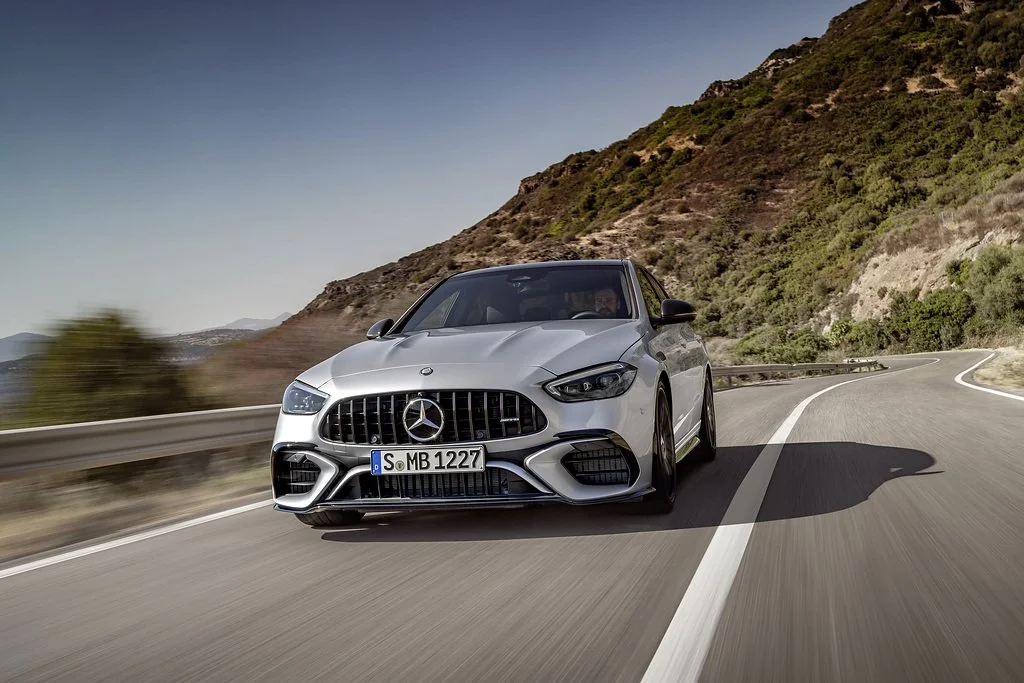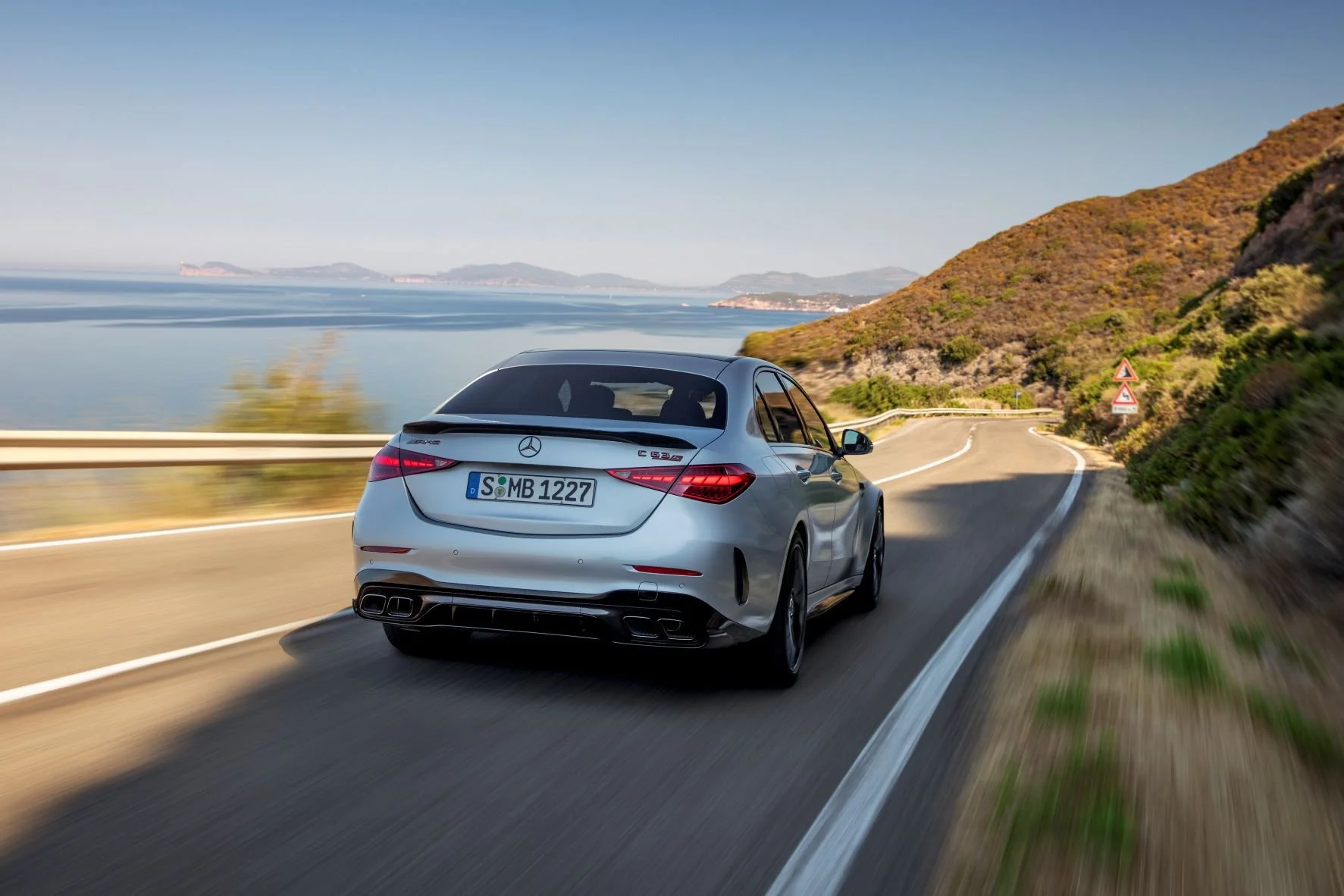Fab phwoar with new C63
/Electric-assisted powertrain has F1 touches and wallops defunct V8 for grunt. Arriving in NZ in mid-2023.
‘THE most powerful production version of the saloon seen to date.’
That hook, baited with promise of a stunning 507kW power, gargantuan torque and 0-100kmh in 3.4 seconds, is being used by Mercedes AMG in convincing fans of its next C 63, unveiled internationally overnight, of its landmark change – a switch from V8 to a four-cylinder.
Now there’s a 2.0-litre turbocharged four-cylinder hybrid-assisted powertrain identified by an E Performance badge that, the maker assures, has the goods to be a relevant and hugely respectable replacement for the sonorous 4.0-litre twin turbo V8 engine that has powered all AMG 63 models since 2015.
Kiwis are expected to find out for themselves around June, 2023, Mercedes Benz NZ has indicated. It further cites that the car will prove worth as “…one of the most advanced performance cars to arrive on our shores.” Nothing like confidence, right?
The new engine, Mercedes says, is the most powerful four-cylinder unit in the world and employs some of the expertise it has acquired over the years from its racing programmes including an innovative new turbocharging system and a high-performance plug-in hybrid powertrain.
Combined system outputs are around 500kW and 750Nm – 125kW and 50Nm higher than the outgoing eight-cylinder C63 S – and hence why it’s the first C 63 to have all-wheel-drive.
The engine churns out 355kW on its own and, when combined with the rear-mounted 152kW electric motor (fed by a battery mounted over the rear axle for optimum weight distribution), the system can send a hefty 1020Nm of torque to all four wheels through a complex all-wheel-drive arrangement of prop-shafts, a two-speed electric gearbox, nine-speed multi-clutch transmission and a rear limited-slip differential.
Another technology is a electrically assisted turbocharger that, rather than being driven by exhaust gases, uses a tiny electric motor to keep the wheel spinning and maintain turbo boost pressure at all times. Benz says its system avoids lag, the momentary delay between the driver putting their foot down and the engine responding.
The electric motor also helps to smooth out the overall power delivery under harsh acceleration. That 152kW peak only avails in 10 second bursts; in everyday use, its continuous output is around 71kW.
The C 63 S is technically a plug-in hybrid, and it has an on-board 3.7kW AC charger to top-up the 6.1kWh directly-cooled battery, but electric pure range is only 13km. The purpose of the battery and motor is more to aid with the power delivery.
In respect to that, it’s not just there to feed the backs. If the control systems detect slippage in one of the rear wheels, the motor can instantly send more power to the fronts to increase traction.
Compared to an everyman C-Class sedan, the C 63 is actually slightly bigger all round. The front wheel track is wider thanks to reworked suspension resulting in arches that are 76mm wider than the standard car. The front has been lengthened by 50mm, too and its 83mm longer overall than the base. Even the wheelbase has grown by 10mm.
The interior provisions with two sports seat options, one more heavily bolstered than the other. Behind the steering wheel is a large rectangular digital instrument cluster with a portrait-aspect infotainment touchscreen in the centre running the latest MBUX.
The C 63 S can be driven in a range of self-explanatory driving modes, all selectable via the infotainment screen, and running the gamut from ‘Electric’ to ‘Race’.
‘Electric’ keeps the car in electric-only mode until the driver demands more power or the battery runs down. ‘Race’ is the most extreme and is designed mainly for track use.
Between those are ‘Slippery’ which, as the name suggests, is designed for trickier conditions and surfaces and the already familiar ‘Comfort’, ‘Sport’ and ‘Sport Plus’, both which incrementally sharpen the throttle response and gear shifts and turn up the boost from the motor.
Also selectable is the level of damping, with the suspension using steel springs and adaptive dampers that allow drivers to choose between three different damping maps - Comfort, Sport and Sport+ - that change the firmness of the ride and thus how the car behaves on the road.
Six-piston fixed brake calipers up front and floating one-piston calipers at the rear feature, but as well as mechanical braking, there are also four levels of regenerative braking ranging from nearly no regen to full one-pedal driving.
The E-Performance badge is not just for this model. It is also destined for a version of the AMG SL roadster and seems set to show on the next E63, which is also on the route for this same engine. Likewise the forthcoming CLE coupe, set to replace the current C-Class and E-Class two-doors, and the next GLC 63 crossover.




















